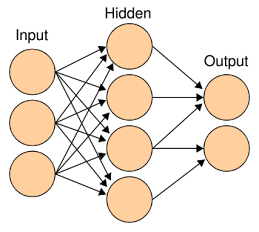An important application of neural networks is pattern recognition. Pattern recognition can be implemented by using a feed-forward (figure 1) neural network that has been trained accordingly. During training, the network is trained to associate outputs with input patterns. When the network is used, it identifies the input pattern and tries to output the associated output pattern. The power of neural networks comes to life when a pattern that has no output associated with it, is given as an input. In this case, the network gives the output that corresponds to a taught input pattern that is least different from the given pattern.
This pattern recognition can be compared with the game chess. With the help of this pattern recognition technique we can also analyse the game chess. For every step or move in the game there occurs a consequence and different possible options are possible to counter the step or move. Perfect move is evolved only when one move is selected from different possible combinations. With the help of this pattern recognition technique we can remember the steps and their outputs and the possible combinations to counter that step. The number of legal positions in chess is estimated to be between 1043 and 1050, with a game-tree complexity of approximately 10123. The game-tree complexity of chess was first calculated by Claude Shannon as 10120, a number known as the Shannon number. Typically an average position has thirty to forty possible moves, but there may be as few as zero (in the case of checkmate or stalemate) or as many as 218.In this way with the help of pattern recognition technique, after remembering those all steps we can master the game of chess.
Thursday, May 15, 2008
Subscribe to:
Posts (Atom)
